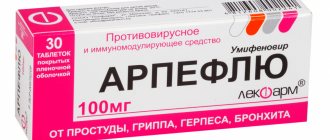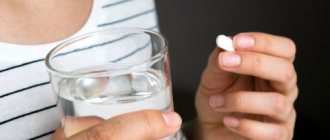Indications for use
What are Libexin tablets for? This drug is used for:
- surgical intervention on the pleura;
- pulmonary infarction;
- pleuropneumonia;
- exudative and dry pleurisy ;
- emphysema;
- flu;
- bronchial asthma;
- chronic and acute bronchitis ;
- any non-productive cough;
- cough at night in patients with heart failure.
Libexin 100 mg 20 pcs. tablets chinoin pharmaceutical and chemical work
pharmachologic effect
Prenoxdiazine is a peripherally acting antitussive agent. The drug blocks the peripheral parts of the cough reflex due to the following effects:
- local anesthetic effect that reduces irritability
- peripheral sensory (cough) receptors of the respiratory tract;
- bronchodilator effect, due to which receptors are suppressed
- stretching involved in the cough reflex;
- slight decrease in the activity of the respiratory center (without respiratory depression).
The antitussive effect of the drug is approximately equal to that of codeine. Prenoxdiazine does not cause addiction or drug dependence. In chronic bronchitis, the anti-inflammatory effect of prenoxdiazine has been noted.
Prenoxdiazine does not affect central nervous system function, with the exception of a possible indirect anxiolytic effect.
Composition and release form Libexin 100 mg 20 pcs. tablets chinoin pharmaceutical and chemical work
Tablets - 1 tablet:
- Active substance: prenoxdiazine hydrochloride 100 mg.
- Excipients: glycerol (glycerin), magnesium stearate, talc, povidone, corn starch, lactose monohydrate.
20 pcs. - blisters (1) - cardboard packs.
Description of the dosage form
The tablets are white or almost white, round, flat, beveled on both sides, with “LIBEXIN” engraved on one side and a score dividing the tablet into four parts on the other.
Directions for use and doses
The average dose for adults is 100 mg 3-4 times/day (1 tablet 3-4 times/day). In more complex cases, the dose can be increased to 200 mg 3-4 times/day or up to 300 mg 3 times/day (2 tablets 3-4 times/day or 3 tablets 3 times/day).
The average dose for children, depending on age and body weight, is 25-50 mg three or four times a day (1/4 - 1/2 tablet 3-4 times a day).
The maximum single dose for children is 50 mg (1/2 tablet), for adults - 300 mg (3 tablets). The maximum daily dose for children is 200 mg (2 tablets), for adults - 900 mg (9 tablets).
When preparing for bronchoscopy, a dose of 0.9-3.8 mg/kg body weight is combined with 0.5-1 mg of atropine 1 hour before the procedure.
The tablets are swallowed without chewing (to avoid anesthesia of the oral mucosa).
Pharmacodynamics
Prenoxdiazine is a peripherally acting antitussive agent. The drug blocks the peripheral parts of the cough reflex due to the following effects: local anesthetic effect, which reduces the irritability of peripheral sensitive (cough) receptors of the respiratory tract; bronchodilator effect, due to which the stretch receptors involved in the cough reflex are suppressed; slight decrease in the activity of the respiratory center (without respiratory depression). The antitussive effect of the drug is approximately equal to that of codeine. Prenoxdiazine does not cause addiction or drug dependence. In chronic bronchitis, the anti-inflammatory effect of prenoxdiazine has been noted. Prenoxdiazine does not affect central nervous system function, with the exception of a possible indirect anxiolytic effect.
Pharmacokinetics
Prenoxdiazine is rapidly and substantially absorbed from the gastrointestinal tract. The Cmax of prenoxdiazine is achieved 30 minutes after taking the drug, its therapeutic concentration is maintained for 6-8 hours.
The binding to plasma proteins is 55-59%.
T1/2 is 2.6 hours.
Most of the dose taken is metabolized in the liver, only approximately 1/3 of the dose taken is excreted unchanged, and the rest in the form of metabolites (4 metabolites of prenoxdiazine have been identified).
During the first 12 hours of metabolism of prenoxdiazine, the most important role is played by biliary excretion of it and its metabolites. 24 hours after administration, 93% of the drug is released. Within 72 hours after oral administration, 50-74% of the dose taken is excreted in feces and 26-50% in urine.
Indications for use Libexin 100 mg 20 pcs. tablets chinoin pharmaceutical and chemical work
- Unproductive cough of any origin (with catarrh of the upper respiratory tract, influenza, acute and chronic bronchitis, pneumonia, emphysema);
- night cough in patients with heart failure;
- when preparing patients for bronchoscopic or bronchographic examination).
Contraindications
- Diseases associated with excessive bronchial secretion;
- state after inhalation anesthesia;
- galactose intolerance, lactase deficiency or glucose-galactose malabsorption;
- hypersensitivity to the drug.
With caution: children's age.
Application of Libexin 100 mg 20 pcs. chinoin pharmaceutical and chemical work tablets during pregnancy and breastfeeding
During pregnancy and lactation, the use of Libexin is possible only if the potential benefit to the mother outweighs the possible risk to the fetus or child.
Use in children
With caution: children's age.
special instructions
The drug may cause complaints from the gastrointestinal tract in patients with lactose intolerance, because tablets contain lactose (0.38 mg lactose per tablet).
Impact on the ability to drive vehicles and perform work associated with increased danger
Taking the drug in high doses can slow down the rate of reactions, therefore, when taking the drug in high doses, the question of the possibility of driving a car or engaging in work associated with increased danger should be decided individually.
Overdose
There are no data on overdose for humans. If a dose exceeds the therapeutic dose, sedation and weakness may develop.
Side effects Libexin 100 mg 20 pcs. tablets chinoin pharmaceutical and chemical work
Allergic reactions: rarely - skin rash; angioedema.
From the gastrointestinal tract: rarely - dry mouth or throat; anesthesia (temporary numbness and loss of sensitivity) of the oral mucosa; in less than 10% of cases - stomach pain; tendency to constipation; nausea.
From the nervous system: when using the drug in high doses - a slight sedative effect; fatigue.
It must be emphasized that both sedation and fatigue occur at doses above therapeutic doses, and all symptoms spontaneously cease within a few hours after stopping the drug.
Drug interactions
It is not recommended to combine the drug with mucolytic and expectorant drugs, because it can impede the release of sputum, which is liquefied by the latter. There are no preclinical or clinical data on interactions with other drugs.
Libexin price, where to buy
The price of Libexin in Russia is on average 600 rubles. In Ukraine, the drug can be purchased for an average of 70 hryvnia.
- Online pharmacies in RussiaRussia
- Online pharmacies in UkraineUkraine
- Online pharmacies in KazakhstanKazakhstan
ZdravCity
- Libexin tablets 100 mg 20 pcs. Chinoin
RUR 609 order
Pharmacy Dialogue
- Libexin (100 mg tablet No. 20)Chinoin
RUR 615 order
show more
PaniPharmacy
- Libexin tablets Libexin tablets.
100 mg No. 20 Hungary, Chinoin 68 UAH. order
show more
Composition of Libexin
Prenoxdiazine is the main active ingredient, the presence of which determines the effectiveness of the drug. The additional components are: magnesium stearate, talc, corn starch and lactose monohydrate. These components are found in many medications available in tablet form.
Prenoxdiazine has the ability to reduce the severity of inflammatory processes in the bronchi. In addition, the substance is a local anesthetic. But its main action is aimed at the peripheral nervous system, which makes it possible to achieve a pronounced antitussive effect. Taking the drug does not cause respiratory depression, and also does not carry the risk of addiction to the active substance.
The principle of action of the drug Libexin
After oral administration, the drug is absorbed into the blood. 30 minutes after administration, the maximum possible concentration of the substance is reached. The therapeutic effect lasts for 8 hours. The half-life is slightly greater than 2.5 hours. More than half of the substance absorbed into the blood is excreted by the liver, where it undergoes metabolic processes. Less than a third of the ingested volume leaves the body unchanged. After taking a dose, after 72 hours, about 70% of the substance is excreted in the feces. The remaining volume leaves the body along with urine.
Due to the fact that the drug has an anesthetic effect, it is not recommended to chew it. The tablets are intended to be taken orally with water.
Once in the body, Libexin significantly reduces the activity of cough receptors. First of all, this is due to the “freezing” effect that the anesthetic effect can achieve. In addition, when absorbed into the blood, the active substance forces the receptors to stretch, the contraction of which leads to a cough impulse. Without depressing breathing, Libexin also acts on the respiratory center, reducing its activity. When compared with other antitussives, Libexin can be placed on a par with codeine in terms of effectiveness.
Libexin tablets: instructions for use
For laryngitis and croup, 1 tablet is prescribed three times a day. This will provide a significant reduction in the sensation of irritation in the throat and soothe inflamed areas. For acute bronchitis, a single dose can be increased to 2 tablets if 100 mg of the drug does not have the expected effect.
The appointment of Libexin may be justified before bronchoscopy. The drug will reduce the sensitivity of the upper respiratory tract and prevent difficulties during the procedure, which may be caused by a narrowing of certain areas of the bronchial tree due to infection.
Libexin is not contraindicated for children, but it is worth keeping in mind that self-administration of antitussives is extremely dangerous for children under 5 years of age. In case of breathing problems of any etiology, the child should be immediately taken to the pediatrician.
A single dose for a child over 5 years old should not exceed 0.5 tablets. A child can take up to 2 tablets per day, each of which will be divided into two/four doses.
For an irritating cough of unknown origin, you can take 1 tablet half an hour before bedtime. This will ensure a good night.
special instructions
It is important to remember that the combination of any antitussive drugs, including Libexin, with mucolytics, expectorants and drugs that dilute sputum is unacceptable.
Taking expectorants is justified in cases where respiratory tract disease is accompanied by complicated sputum discharge, as well as in cases where sputum is not produced in the required amount. As a rule, these are bronchitis of various etiologies. To alleviate the course of bronchitis, you can use mucolytics and other drugs with similar effects. But taking such drugs becomes a contraindication to the use of Libexin, since it blocks the cough reflex.
Sputum, the production of which is provoked by mucolytics and expectorants, must actively exit the respiratory tract, and remove waste products of pathogenic microorganisms along with it. Using Libexin will stop the production of sputum. It will accumulate in the lower respiratory tract, significantly increasing the risk of complications. Microbes in the damp environment of accumulated mucus will be able to multiply more intensively, which will certainly lead to pneumonia.
The use of an antitussive for bronchitis is permissible only at night, in order to ensure restful sleep, provided that the expectorant was taken no later than 3-4 hours before the expected bedtime.

